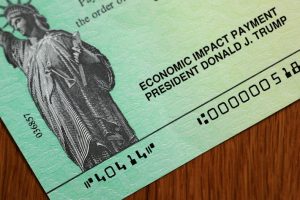If the second round of stimulus checks stays at a $600 per person cap, our stimulus check calculator can help you estimate your household’s expected total.
How much money would you or your family get with a second stimulus check of up to $600 for adults and dependent children? That’s the question once again now that President Donald Trump indicated on Tuesday night that he would not sign the new $900 billion relief bill that Congress passed Monday night, making it law. At least not without a second stimulus check of up to $2,000 per person.
While we monitor that new turn of events, we’ll share what we know now about the way the IRS would calculate the $600 direct payment. Understanding the upper limit is easy, but as with the first payment, there’s a tangle of rules in place that together decide how much stimulus money your household can actually get. For example, the most an adult who qualifies for the second stimulus check can get is $600 apiece. That becomes more complicated as you add in child dependents — each one under 17 years old would bring in an additional $600. And the reality is that with this second round of stimulus payments, more people are expected to hit an income limit that could make them ineligible for any check at all.
Our calculator for this second stimulus check breaks down how much you might be able to receive, based on the rules Congress has set out for this $600 payment (here’s the calculator for the $1,200 stimulus check from March). Keep in mind that our calculator tool is for estimates only, and is not a final figure supplied by the IRS. There may be other factors that could determine the final size of your payment. This tool will not store or share your personal details. This story was recently updated.
Before you estimate your second stimulus check total…
Before you can get an estimate of your second check amount (assuming the $600 upper limit), you’ll need your adjusted gross income (AGI) from your 2019 tax information. On your 2019 federal tax return, you can find that figure on line 8b of 2019 1040 federal tax form. Keep reading for how to estimate your amount if you don’t typically file taxes.
To estimate the amount of the second check, you enter all your child dependents age 16 and younger for $600 apiece. For tax purposes, a single taxpayer claims no dependents, where a head of household is a person who does not file jointly and claims at least one dependent.
Stimulus check qualification basics
Broadly, here’s who is eligible for money with the second stimulus payment. Payments top out at $600 apiece, and as you reach the upper AGI limit, the amount of your check will decrease. A family of four that qualifies, for example, could receive up to $2,400. For a complete breakdown, check out our stimulus check qualifications guide.
To get the full $600 stimulus per person, either:
- As an individual without qualifying children, you have an adjusted gross income of up to $75,000 (this completely phases out at $87,000, down from the $99,000 used for the first check).
- You file as the head of a household (you claim children) and earn under $112,500.
- You file jointly without children and earn less than $150,000 and no more than $174,000 (down from $198,000 from the first check).
- Any dependent child under age 17 will count for an additional $600.
Note, if you don’t qualify for a second stimulus check based on 2019 data but you would qualify based on your 2020 financial situation, you will not receive a second check this year. However, you can get that amount as a credit against your 2020 taxes.
If you qualify based on 2019 tax information but will be over the limit in 2020, you will receive a second check and do not need to repay it.
How would you receive your second stimulus payment?
If the IRS has your banking information on file, either from your federal taxes or from the first stimulus payment, your payment should come directly to your bank via direct deposit. The Treasury Department said as of this summer that about 75% of recipients were paid via direct deposit, 22% by paper check, and 3% through a prepaid EIP card.
When could the payments be sent out?
Soon. According to Treasury Secretary Steven Mnuchin, “The good news is [direct deposit] is a very, very fast way of getting money into the economy. Let me emphasize: People are going to see this money at the beginning of next week.”
Starting in the new year, the IRS will send out payments on paper checks and prepaid EIP cards to those for whom it does not have banking information on file. But sending the payments shouldn’t drag on for months, as the first payments did. By Jan. 15, if the IRS has not sent your payment — or sent the wrong amount — you can claim your money when you file your taxes this year.
What if you aren’t typically required to file taxes?
As with the first checks, the IRS will automatically send stimulus checks to many who normally aren’t required to file a tax return — including older adults, Social Security and SSDI and SSI recipients, certain veterans, and railroad retirees. The IRS refers loosely to this group as nonfilers.
If you fall in one of these categories, enter your best guess in the calculator where it asks for your adjusted gross income.










